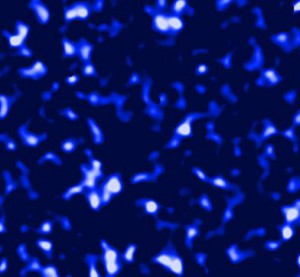
ASTRONOMERS at a Scottish university have mapped a large area of dark matter for the first time.
Dr Catherine Heymans of the University of Edinburgh, Scotland, working with Associate Professor Ludovic Van Waerbeke of the University of British Columbia, Vancouver, Canada, have revealed a Universe comprised of an intricate cosmic web of dark matter and galaxies spanning more than one billion light years.
The pair analysed images of around 10 million galaxies in four different regions of the sky.
They studied the distortion of the light emitted from these galaxies, which is bent as it passes massive clumps of dark matter during its journey to Earth.
They accumulated images over five years using a special camera in Hawaii.
Galaxies included in the survey are typically six billion light years away. The light captured by the images used in the study was emitted when the Universe was six billion years old – roughly half the age it is today.
The team’s result has been suspected for a long time from studies based on computer simulations, but was difficult to verify owing to the invisible nature of dark matter. This is the first direct glimpse at dark matter on large scales showing the cosmic web in all directions.
Professor Ludovic Van Waerbeke, from the University of British Columbia, said: “It is fascinating to be able to ‘see’ the dark matter using space-time distortion. It gives us privileged access to this mysterious mass in the Universe which cannot be observed otherwise. Knowing how dark matter is distributed is the very first step towards understanding its nature and how it fits within our current knowledge of physics.”
Dr Catherine Heymans, a Lecturer in the University of Edinburgh’s School of Physics and Astronomy, said: “By analysing light from the distant Universe, we can learn about what it has travelled through on its journey to reach us. We hope that by mapping more dark matter than has been studied before, we are a step closer to understanding this material and its relationship with the galaxies in our Universe.”